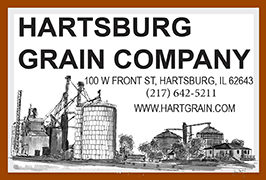|
One can’t help admiring the
work of our farmers! Cruising along with the breeze coming through
the window and watching the swaying of the tops of the corn rows,
it’s almost mesmerizing enough to put you to sleep. You can smell
the good old black dirt full of smells of the growing corn. You're
just sitting back enjoying the slow ride down the deserted road with
your favorite person in peace with the radio faintly playing in the
background.
Then oops!! You can’t help but notice that someone did something
drastically wrong! Why does that field look so different than the
others? You recognize the straight sturdy stalks, the long green
leaves, and the big growing corn ears on the sides, but it’s just so
short! This field looks like something, or someone forgot to do
something major because it is just not a normal field of big, tall,
straight, strong corn. The old saying ‘knee high, by the fourth of
July’ just doesn’t apply to this picture. Surely this is just a
misstep, and you think, hopefully, the rest of this farmer's crops
are more normal…..or are they?

This could be a new hybrid
called short-stature corn or short corn. What is short corn or dwarf
corn? Although it is, fittingly, more common verbiage to the farmers
of the region, it simply means that it is a reduction of the height
of the plant. This corn is a little larger than a half-size version
of standard commercial corn hybrids.
This term has been in the developing stage for more than twenty
years. The thought process, which is not refined to date in corn
production, is to increase the strength and amount of the kernels on
the cob, called the yield.
Short-stature corn could provide a lot of physiological and
practical advantages, including plant sturdiness, increasing the
ability of a corn variety to produce higher yields even when more is
planted per acre. This means that it can withstand the competitive
stress of crowded growing conditions without a significant reduction
in yield compared to older varieties that might struggle under such
conditions. More modern corn hybrids are genetically bred to
tolerate being planted closer together. Another advantage is having
the ability to use ground equipment to apply fungicide, herbicide,
and put on fertilizers, which will be a more efficient use of
resources.

Short corn also has a
reduction in the stalk biomass, which simply means that the total
weight or mass of all plant material from the corn crop (stalk,
leaves, cobs, grain) can still be used as a renewable energy source.
This leftover part, or the corn stover or trash as it is referred
to, is the main component for biofuel production like ethanol.

Short corn is just shorter.
However, it still maintains the size, number of leaves, and the same
reproductive tissues, allowing a more efficient way to portion out
the nutrients and energy. There have been a lot of studies done on
short corn versus the traditional height of corn, and one claim is
that with the short corn, you can plant more rows per acre,
increasing the amount of yield because narrower rows can be planted.
Another hopeful advantage is the durability of the short corn. By
being closer to the ground, the wind and storms may not cause it to
lay down, break the stalks, or damage the ears as much.
[to top of second column] |

However, because of the
shortness of the stalk, the ear on the stalk must be a specific
height above the soil surface so that the current combine headers
can harvest properly. If not, it could add wear or the need to add
additional parts to the machine. However, some farmers argue that
the shortness of the corn does not give it enough height to shadow
out the sun to help prevent unwanted weeds from growing as fast.
An interesting benefit that they have seen during the testing is
that the roots of the corn seem to have developed stronger and
faster than traditional corn seeds, which the hope is that this
reasoning means that the roots can explore more soil volume, which
will allow them to take advantage of more nutrients. Long-term, that
means that they are hopeful that they can get the same amount out of
the soil that is currently applied to end up with more yield.

Short corn is a new concept
that is fun to take care of, and it is interesting to see everyone’s
reactions to it, with most wondering if the shorter corn will be
better with all the many different weather events we are now seeing
across the Midwest.
Overall, there are many different hybrids, and companies will
continue to research, develop, and grow many different products in
their test lots. Just as these companies have done for many years in
the past, they will continue to do so for many years to come. The
ultimate goal is to improve U.S. corn production, change and enhance
the ease and efficiency of in-season nutrients and crop protection
applications, and improve resiliency to adverse weather conditions.
Resources:
What are the advantages of short corn? - Stine
Seed
Short-Stature Corn Hybrids: Next Evolution in
U.S. Corn Production?
#TraitAnswers | What Are Short Stature Corn
Hybrids? | Crop Science US
Exploring the Potential for Reduced-Stature
Corn | Pioneer® Seeds
Will 'short corn' change the landscape of the
rural Midwest? | WCBU Peoria
‘Short corn’ could replace towering cornfields
steamrolled by changing climate | The North State Journal
|